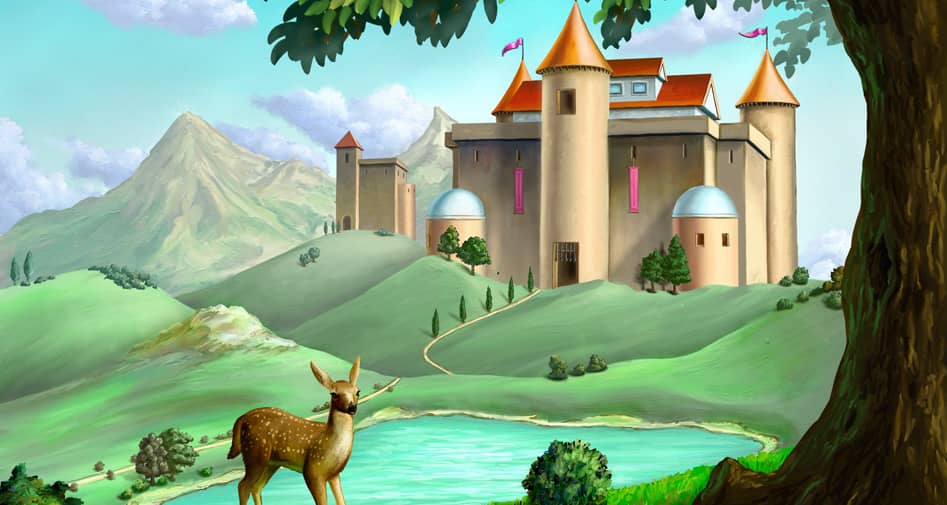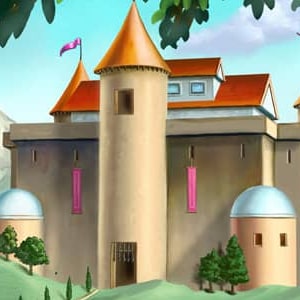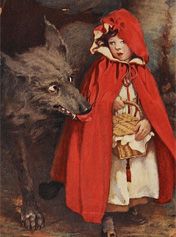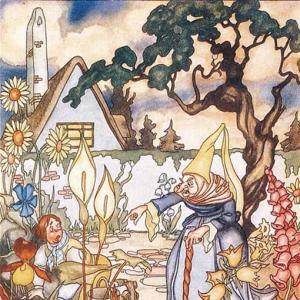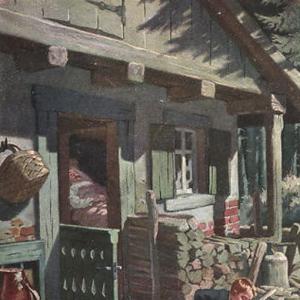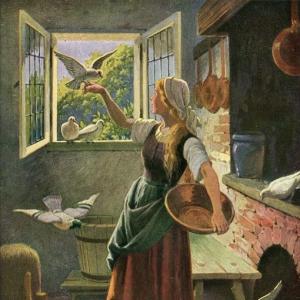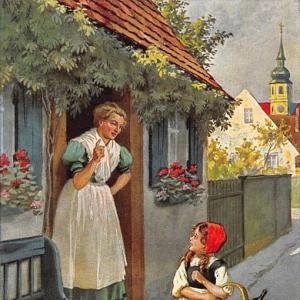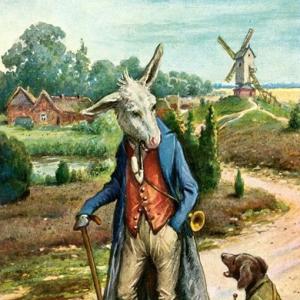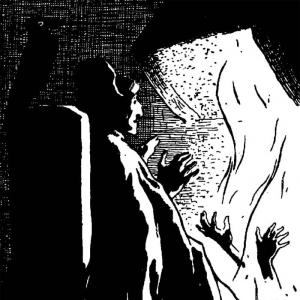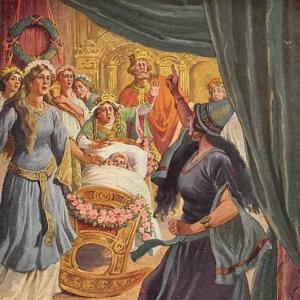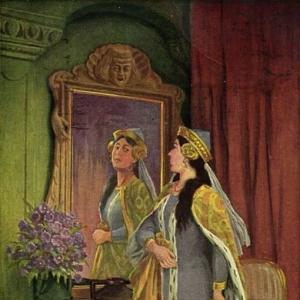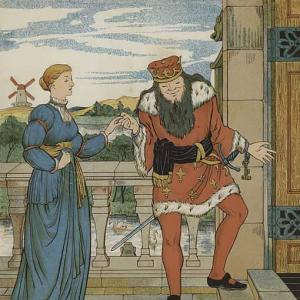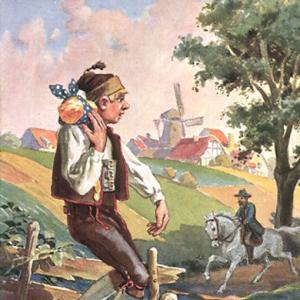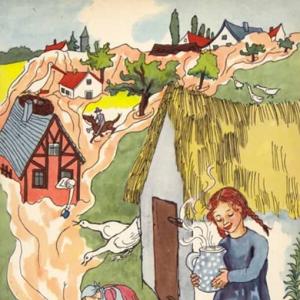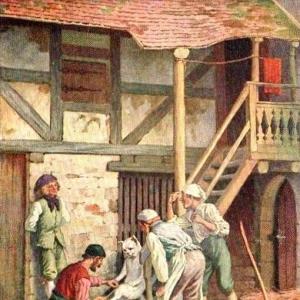Reading time for children: 2 min
Three women were changed into flowers which grew in the field, but one of them was allowed to be in her own home at night. Then once when day was drawing near, and she was forced to go back to her companions in the field and become a flower again, she said to her husband: „If thou wilt come this afternoon and gather me, I shall be set free and henceforth stay with thee.“ And he did so. Now the question is, how did her husband know her, for the flowers were exactly alike, and without any difference?
Answer: „As she was at her home during the night and not in the field, no dew fell on her as it did on the others, and by this her husband knew her.“
 Learn languages. Double-tap on a word.Learn languages in context with Childstories.org and Deepl.com.
Learn languages. Double-tap on a word.Learn languages in context with Childstories.org and Deepl.com.Backgrounds
Interpretations
Adaptions
Summary
Linguistics
„A Riddling Tale“ is a short fairy tale collected by the Brothers Grimm, Jacob and Wilhelm, who were German academics, linguists, cultural researchers, and authors. They are best known for their work in compiling and publishing folk tales, fairy tales, and legends from the oral tradition of the German-speaking people during the 19th century. Their collection, „Children’s and Household Tales“ (also known as „Grimms‘ Fairy Tales“), was first published in 1812 and has since become a foundational work in Western folklore.
The Brothers Grimm aimed to preserve these stories as a way to document and maintain the cultural heritage of their region. Many of the tales they collected have become widely recognized around the world and have inspired numerous adaptations in literature, theater, and film. Some of the most famous stories include „Cinderella,“ „Snow White,“ „Hansel and Gretel,“ „Rapunzel,“ and „Rumpelstiltskin.“
„A Riddling Tale,“ although not as well-known as some of the other stories in the collection, is an example of a simple yet thought-provoking narrative that uses riddles and challenges to engage the reader. It illustrates the Brothers Grimm’s dedication to collecting a diverse range of tales, showcasing different aspects of human experience and emotion, as well as their desire to document the cultural heritage of the German-speaking people.
„A Riddling Tale“ by Brothers Grimm can be interpreted in several ways, depending on the reader’s perspective. Here are a few possible interpretations:
The power of love and devotion: The tale demonstrates the strong bond between the husband and his enchanted wife. Despite the challenging circumstances, the husband is determined to find a way to recognize his wife and set her free. This can be seen as a metaphor for the power of love to overcome obstacles and reunite loved ones.
The importance of paying attention to details: The husband’s ability to identify his wife among the identical flowers highlights the significance of paying attention to the small details that differentiate one thing from another. This can be a reminder to be observant and value the unique aspects of people or situations, as these details can sometimes be crucial to solving problems or making informed decisions.
Adaptation and transformation: The three women’s transformation into flowers can be seen as a metaphor for adaptation and change. The tale may be suggesting that life often presents us with unexpected challenges that require us to adjust our perspectives and adapt to new situations. In this case, the woman’s ability to return home at night shows her resilience and adaptability in the face of adversity.
The power of knowledge: The story illustrates how having the right information at the right time can make a significant difference in one’s life. The wife’s knowledge of how to break the spell and the husband’s awareness of the dew’s significance ultimately leads to the wife’s freedom. This underscores the importance of seeking and applying knowledge to overcome challenges.
Overall, „A Riddling Tale“ offers multiple interpretations that can inspire readers to reflect on the themes of love, attention to detail, adaptability, and the value of knowledge.
The fairy tale „A riddling tale“ from Brothers Grimm has been adapted in various forms of media, including books, films, and television shows. Some of the notable adaptations include.
The animated film „The Riddle“ (2007) directed by Andrew Belling, which is based on the fairy tale and features a similar storyline and characters.
The children’s book „The Riddle of the Seventh Stone“ (2004) by Monika Wittmann, which is a modern retelling of the fairy tale with a new twist on the riddle and the soldier’s quest.
The television series „Once Upon a Time“ (2011-2018), which features the character Rumpelstiltskin as a recurring character who often poses riddles and challenges to the other characters.
The video game „King’s Quest VI: Heir Today, Gone Tomorrow“ (1992), which features a storyline that is loosely based on the fairy tale and includes a character who poses riddles and challenges to the player.
The stage play „The Riddle of the Sphinx“ (2008) by David Mamet, which is a modern adaptation of the Oedipus myth that incorporates elements of the fairy tale.
These adaptations demonstrate the enduring popularity and influence of the fairy tale „A riddling tale“ from Brothers Grimm, and how its themes and characters continue to resonate with audiences today.
„A Riddling Tale“ is a short fairy tale by Brothers Grimm that tells the story of three women who were transformed into flowers. They grew in a field, but one of them was allowed to return to her home at night. As the day approached, she had to go back to the field and transform back into a flower. Before leaving, she told her husband that if he came to the field in the afternoon and picked her, she would be set free and could stay with him permanently.
The main challenge in the story is how the husband could identify his wife among the identical flowers in the field. The solution to this riddle lies in the fact that since the woman spent her nights at home and not in the field, she did not have dew on her like the other flowers. The husband recognized her by the absence of dew, picked her from the field, and thus set her free to live with him once again.
The fairy tale „A Riddling Tale“ by the Brothers Grimm presents an interesting narrative structure and employs several linguistic and thematic elements that are characteristic of folklore.
Simplicity and Clarity: The language used in the tale is straightforward and clear, which is typical of traditional fairy tales meant to be easily understood by listeners of all ages. The sentences are concise and convey the actions and thoughts of the characters directly.
Repetition: The tale uses repetition to reinforce the sequence of events and the magical transformation that is central to the story. The phrase „changed into flowers“ is indicative of the magical realism often found in fairy tales.
Dialogue: The dialogue is minimal but crucial. The wife’s words to her husband are direct and serve to advance the plot. Her statement, „If thou wilt come this afternoon and gather me, I shall be set free,“ creates a sense of urgency and a clear task for the husband.
Riddle Structure: The narrative is framed as a riddle, a common element in folklore. The riddle arises from the husband’s task of identifying his wife among identical flowers. This engages the audience in problem-solving and adds an interactive dimension to the tale.
Theme of Transformation and Liberation: The tale explores themes of transformation, entrapment, and liberation, which are common in fairy tales. The wife’s transformation into a flower and her eventual return to human form symbolize themes of metamorphosis and the power of love to overcome enchantment.
Use of Symbolism: Flowers in fairy tales often symbolize beauty and fragility. Here, they also represent the trapped state of the women. The dew is a subtle but significant symbol that helps resolve the riddle and represents purity and freshness, setting the wife apart from the others.
Temporal Setting: The reference to time („day was drawing near,“ „this afternoon“) provides a temporal framework that is often used in fairy tales to build suspense and urgency.
Moral and Resolution: The resolution of the tale, where love and attentiveness lead to liberation, imparts a moral lesson. The husband’s ability to recognize his wife despite their identical appearances speaks to themes of fidelity and perceptiveness.
Overall, „A Riddling Tale“ uses these linguistic and thematic elements to engage the audience in a narrative that is both entertaining and thought-provoking, while also delivering a subtle moral message.
Information for scientific analysis
Fairy tale statistics | Value |
|---|---|
| Number | KHM 160 |
| Aarne-Thompson-Uther-Index | ATU Typ 407 |
| Translations | DE, EN, DA, ES, FR, PT, IT, JA, NL, PL, RU, TR, VI, ZH |
| Readability Index by Björnsson | 37.7 |
| Flesch-Reading-Ease Index | 75.6 |
| Flesch–Kincaid Grade-Level | 9.2 |
| Gunning Fog Index | 12.3 |
| Coleman–Liau Index | 6.8 |
| SMOG Index | 9.5 |
| Automated Readability Index | 9.8 |
| Character Count | 662 |
| Letter Count | 503 |
| Sentence Count | 5 |
| Word Count | 131 |
| Average Words per Sentence | 26,20 |
| Words with more than 6 letters | 15 |
| Percentage of long words | 11.5% |
| Number of Syllables | 162 |
| Average Syllables per Word | 1,24 |
| Words with three Syllables | 6 |
| Percentage Words with three Syllables | 4.6% |
